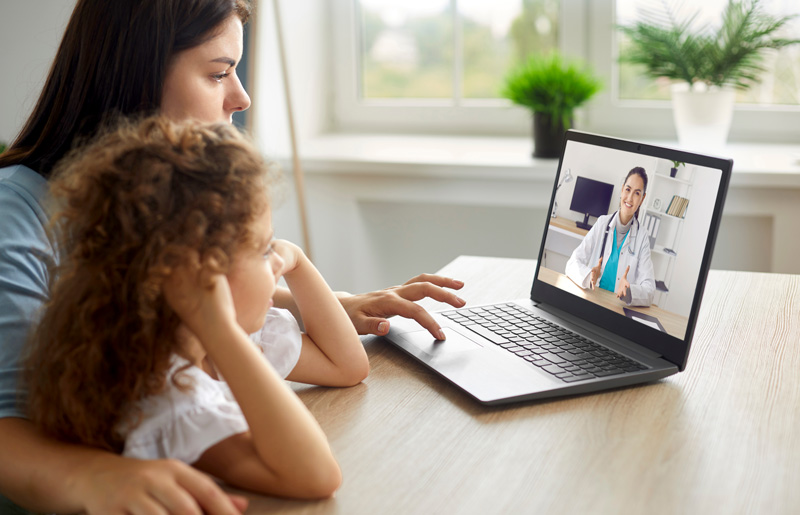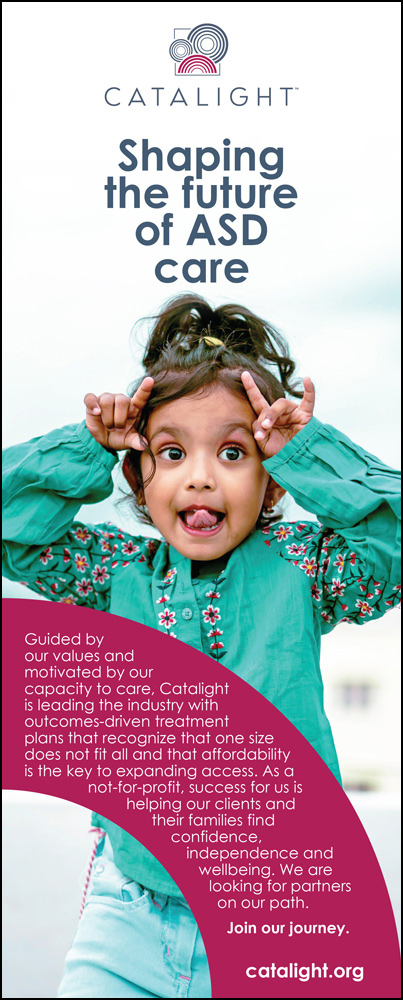Since the COVID-19 pandemic, the availability of telehealth for autism and other developmental disorders has exploded. Now that we are mostly post-pandemic, many parents are asking: “Is telehealth still the right choice for my child’s treatment?” There is no single answer. Below are several considerations for parents to keep in mind if they are thinking of starting telehealth – or if they are wondering about switching from telehealth to in-person care for their child’s Behavioral Health Treatment (BHT). BHT includes treatment such as applied behavior analysis (ABA) services and non-ABA care.

Is Telehealth Right for My Family’s Collective Wellbeing?
Rather than asking if telehealth is right for their child, I encourage parents to broaden the question: “Is telehealth right for my family’s collective wellbeing?” That’s a subtle, but significant change in perspective. Among parents of children with disabilities, parents of autistic children report some of the highest levels of stress. Telehealth comes with some practical benefits to parents and other caregivers that are often under-discussed, including: less time traveling to and from appointments; less money spent on transportation; less time spent in waiting room; and less disruption to their family’s routine. These non-clinical issues are often overlooked but can be important contributors to the overall wellbeing of a family.
How Does Telehealth Fit with the Type of Treatment My Child Is Receiving?
Another question to ask: “How does telehealth fit with the type of treatment my child is receiving?” BHT for children and youth with autism or other developmental disabilities is provided in two ways. Parent-mediated (also called parent or caregiver-led) or paraprofessional-mediated (also called practitioner-mediated).
In parent-mediated BHT, parents or other caregivers are taught how to implement their child’s treatment plan. A certified or licensed clinician will coach and support them in this. Parent-mediated BHT has been shown to be just as effective or even more effective than the paraprofessional model of BHT. The advantage of this way of providing treatment is that parents can use what they learn to teach their child or respond to behaviors at any time they are with their child. We sometimes think of this way of providing BHT as teaching parents to parent differently.
In paraprofessional-mediated BHT, a paraprofessional under the supervision of a certified or licensed clinician teaches the paraprofessional to work directly with the child. The paraprofessional often comes to the home a certain number of hours a week but this type of BHT can also be done in a clinic.
Parent-mediated BHT delivered via telehealth comes with some unique benefits. The clinician has the opportunity to virtually observe the child at home in their everyday environment without the disruption or change in behavior that can come when a third-party is in their home – or when the child is in new environment. Some parents use ear buds to receive real-time coaching from the clinician, who can turn off their camera, so the child is not distracted by their virtual presence.
In contrast, paraprofessional-mediated BHT delivered via telehealth may mean increased screen time for the child, which some parents are concerned about. For very young children, paraprofessional-mediated BHT delivered via telehealth may not be realistic or advisable.
What Does the Research Tell Us About Telehealth?
Another important consideration: “What does the research tell us about telehealth?” Research into the efficacy of BHT delivered via telehealth began before the pandemic. Overall, the data show that telehealth is very effective and that many parents find telehealth helpful and easy. A few key points from research published over the past five years:
- A 2018 review of 14 telehealth studies found that telehealth is effective and produces similar results to in-person BHT (Sutherland et al., 2018)
- A 2020 study of telehealth by Lindgren and colleagues found that parent-mediated telehealth BHT improved communication and social skills and decreased behavior problems in young children.
- A 2019 study by Wallisch and colleagues looked at parent perceptions of telehealth and reported that parents appreciated the way telehealth was compatible with daily life and found coaching by telehealth very helpful.
- A 2022 study found that a BHT program that provides social skill training for teens with autism was just as effective through telehealth as in-person (Estabillo et al., 2022).
Which Providers Are Available in Person Versus via Telehealth?
Another important question: “Which providers are available in person versus via telehealth?” Once families are no longer tied to providers in their drivable geographic area, their choices are likely to expand. Telehealth may allow parents greater opportunity to select caregivers who are a good fit for their family’s needs. This is particularly important for parents in areas where there is limited access to autism care. For some parents, especially in rural areas, telehealth may be their only realistic option. Having an increased ability to select well-qualified providers that parents are comfortable working with can be an important contributor to the success of their child’s treatment.
For older children, parents should consider their preferences, talking to their tweens and teens to find out what they prefer. Allowing youth to choose how they receive treatment can improve their buy-in for participating.
I also encourage parents considering telehealth to talk with other parents in their situation to learn from their experiences, and to discuss the decision with their existing care team.
A final word: This doesn’t need to be an all-or-nothing decision. Parents can utilize a hybrid approach that mixes in-person treatment with telehealth and can change their approach as their family’s needs and circumstances change.
Doreen Samelson, EdD, MSCP is the Chief Clinical Officer of Catalight, a nonprofit that provides access to innovative individualized care services, clinical research, and advocacy – so people with developmental disabilities can choose their path. Samelson is a licensed clinical psychologist and leads the organization’s behavioral health research team with a focus on promoting the overall well-being of families.
References
Estabillo, J. A., Moody, C. T., Poulhazan, S. J., Adery, L. H., Denluck, E. M., & Laugeson, E. A. (2022). Efficacy of PEERS® for Adolescents via Telehealth Delivery. Journal of Autism and Developmental Disorders, 52(12), 5232–5242. https://doi.org/10.1007/s10803-022-05580-5
Lindgren, S., Wacker, D., Schieltz, K., Suess, A., Pelzel, K., Kopelman, T., Lee, J., Romani, P., & O’Brien, M. (2020). A Randomized Controlled Trial of Functional Communication Training via Telehealth for Young Children with Autism Spectrum Disorder. Journal of Autism and Developmental Disorders. https://doi.org/10.1007/s10803-020-04451-1
Sutherland, R., Trembath, D., & Roberts, J. (2018). Telehealth and autism: A systematic search and review of the literature. International Journal of Speech-Language Pathology, 20(3), 324–336. https://doi.org/10.1080/17549507.2018.1465123
Wallisch, A., Little, L., Pope, E., & Dunn, W. (2019). Parent perspectives of an occupational therapy telehealth intervention. International Journal of Telerehabilitation, 11(1), 15–22. https://doi.org/10.5195/ijt.2019.6274








[…] Since the COVID-19 pandemic, the availability of telehealth for autism and other developmental disorders has exploded. Now that we are mostly post-pandemic, many parents are asking: “Is telehealth still the right choice for my child’s treatment?” There is no single answer. Below are several considerations for parents to keep in mind if they are thinking of starting telehealth – or if they are wondering about switching from telehealth to in-person care for their child’s Behavioral Health Treatment (BHT). Read More […]